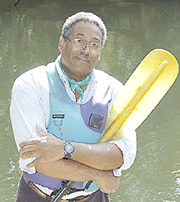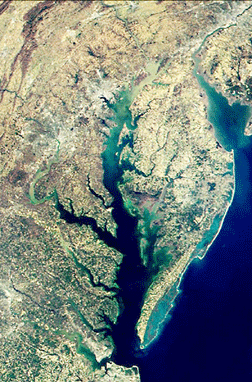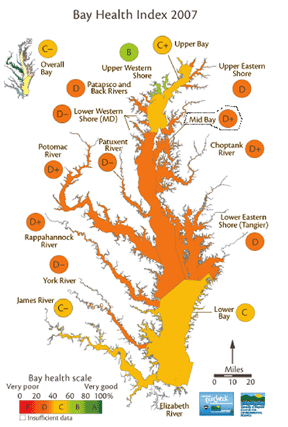Low Marks for Our WatershedTo get its grades up, Chesapeake Bay’s waterways need you
|
 |
“Half of the days we tested, dissolved oxygen levels were so low they wouldn’t support fish life,” reported West/Rhode Riverkeeper Bob Gallagher. |
Still, no one improvement is a panacea. Sewage upgrades, for example, can’t stop many of the nutrients that seep from lawns and paved surfaces responsible for most of the tributaries’ grades: D.
“We are not on the road to recovery,” writes Dennison. That’s not news to riverkeepers who are searching for solutions — and ways to make those solutions work.
Troubled Riverkeeepers
From what South Riverkeeper Drew Koslow has seen out on the water, the South River Federation’s score of 34 percent of its goal for the river came as no surprise. For the South River, a score of 100 represents the river’s condition in the 1950s and ’60s. The Federation graded its own river on shorelines, underwater grasses, dissolved oxygen and more with sub-scores — like two out of 10 for water clarity and five out of 10 for dissolved oxygen — for an averaged score of 34 out of 100.
“Water quality has been getting worse in the four years we’ve been doing the monitoring,” Koslow said. Water quality and scores were especially low last year because of severe algae blooms. “That drove our score because it affected dissolved oxygen and water clarity,” Koslow said. In 2006, the South River’s first report card came in with a slightly higher score of 37.
Neither, on the West and Rhode Rivers, does riverkeeper Bob Gallagher see evidence of improvement.
“It’s steady or slightly worse,” he says. “We looked pretty good on bacteria, but that’s because it didn’t rain all summer.”
On the West and Rhode rivers, water-quality testers measured water clarity, dissolved oxygen, underwater grasses and bacteria. Scores were based on how close measurements were to the Chesapeake Bay Program’s standards. The West River’s dissolved oxygen levels met the targets 62 percent of the time; the Rhode River followed at 54 percent. Underwater grasses fared worse, as the Virginia Institute of Marine Science’s autumn aerial survey showed no underwater grasses in both rivers — though Gallagher says that locals have found tiny patches of spring-growing grasses.
To the west and south, the Patuxent River has been a cause for three decades. Even after litigation, numerous wade-ins with ample press coverage, a dedicated riverkeeper and hundreds of eco-minded citizen cleanups, the Patuxent flowed through 2007 with a D- grade.
The Bay’s GradesChesapeake watershed: C- (University of Maryland Center for Environmental Science)Patuxent River: D- (Patuxent Riverkeeper)South River: D (South River Federation)West/Rhode Rivers: [no overall grade, but similar results to the South and Patuxent rivers] |
A bad way to kick off the Patuxent Riverkeeper’s first-ever report card, the D- grade “wasn’t a surprise,” said Tutman, who scoured state and federal water quality and biological data with his riverkeeper staff and the University of Maryland Center for Environmental Sciences.
The Patuxent’s scores ranged from good to very poor: the upper reaches received a 94 percent while the middle got a zero for water clarity. The report card also showed how the river’s overall health slid downhill as water moved downstream. In the longest intrastate waterway in Maryland, the upper river near Upper Marlboro fairs the best — with a C- grade. As water flows to the Bay, conditions get worse. The middle of the Patuxent, on the western side of Calvert, gets a D grade. By the time the river reaches Solomons, the lower river registers a grade of F.
The scores didn’t surprise Tutman because, as he said, “we haven’t changed anything. What we’ve done is legislative and policy based, but we haven’t implemented many of the changes yet, like the Stormwater Act of 2007.”
What’s Wrong
“The key enemy of the South River continues to be impervious surfaces,” writes Kincy Potter, president of South River Federation’s board of directors.
 |
photo by Kirsten Beckerman
|
Same goes for the Patuxent, West and Rhode rivers: excess nutrients and sediment runoff are the biggest problem. On average, nearly 15 pounds of nitrogen per acre run off land that’s developed, according to the Patuxent’s scorecard. Farmed land contributes a little less, at 11.7 pounds per acre.
With over 53 percent of the watershed covered by agriculture or urban development, people have to change their ways for the estuary to heal itself.
“Half of the days we tested, dissolved oxygen levels were so low they wouldn’t support fish life,” reported Gallagher, whose Riverkeeper program issued a report in April, with facts on five different areas rather than a single score.
Scores came in low, but Gallagher has a reason to remain hopeful.
“What scientists have found is that when we reduce nitrogen and phosphorus to target levels, lots of forms of life come back fairly quickly, so that’s a reason to be optimistic,” says Gallagher, whose own water-quality teams determined that water clarity met Chesapeake Bay Program standards only one percent of the time last year from May to October.
Impervious surfaces — combined with stormwater runoff — connect our lawns, rooftops and driveways more easily with our waterways. The EPA found that 70 percent of fertilizer applied to yards across the country washes off, Koslow said. “If people can use an organic fertilizer in the fall, that would make a big difference; spring and summer are when water is most vulnerable to increases in nutrients.”
Can We Boost Our Grades?
Boil down our grades and report cards, and you’ll see that it’s not the rivers that need to work harder: We do.
“We graphed a series of wade-ins over a dozen years to show track or trend,” Tutman says. “Overall, you see a steady, going-down factor. The way things typically work is flatlined, and flatline isn’t good because that means nothing has changed.”
It could be worse, Tutman reminds us: “If we did nothing,” he said, “these numbers would be worse.”
But to do more, we must find ways to slow sediment and nutrient runoff.
“It’s not trash cleanups; beer cans are not on [the report card],” Tutman says. “That’s not what translates into robust bio-system, a healthy benthic community.” True cleaning must start from the land where we live and work.
Restoration projects do good, say the riverkeepers, but the real improvements will come from people — everyone — making changes at home and in their lifestyles.
 |
photo courtesy of Patuxent Riverkeeper
|
Get Picky
To raise our grades for next year, we’ll have to change our attitudes — and convince our neighbors to do the same.
“People need to get as picky about their water as anything else that they are consumers of,” Tutman says. “They want the best — but they’re actually getting hand-me-down, marginal, undrinkable un-swimable water.”
That means getting picky about our elected officials, too, Gallagher says.
“People need to think more about the bigger picture,” Gallagher says, and support candidates that are willing to make solid changes, even in the face of politics.
There’s more we can do. Keeping track of your local waterways — reading scorecards when they come out — helps you to stay in the know. Especially if you live near a river, help get impervious surface runoff under control by using rainbarrels to keep water on your property longer and pump out your septic system at least every three years.
Finally, support your local riverkeepers to help figure out the solution. Strength comes in numbers. This spring, Koslow and a group of clean-up volunteers pulled some 500 tires out of an area adjacent to Church Creek.
“We’re a source where the more people join in,” Koslow says, “the more likely it is that we’ll get something accomplished.”
Find out more that you can do:
• www.westrhoderiverkeeper.org
© COPYRIGHT 2008 by New Bay Enterprises, Inc. All rights reserved.



 ” Tutman recalled in amazement. Cutting the trees next to the river would indeed hurt its ecology, and Tutman said so.
” Tutman recalled in amazement. Cutting the trees next to the river would indeed hurt its ecology, and Tutman said so.